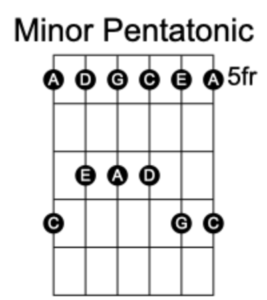The pentatonic scale is very useful when creating guitar solos on different keys, both minor and major.
One of the first scales used by guitar players is the pentatonic, which is composed of five notes.
The pentatonic scale can be built over the major or the minor key. Both ways of building the scale are equivalent, as you’ll see later.
The Minor Pentatonic
First, consider the minor pentatonic. This scale has, as the name implies, five notes from the minor scale.
The easy way to remember this is to remind the missing notes from the natural minor: the pentatonic omits the 2nd degree, as well as the 6th.
For example, in the A minor key, the pentatonic will the include the following notes: A, C, D, E, and G.
In the guitar, this can be translated into an easy pattern that is easily remembered:

The use of the minor pentatonic is clear when playing minor chords. However, you don’t need to use the same pentatonic as the chord name.
For example, if you’re playing A minor, you can chose either the A minor pentatonic, or you can also use the D minor pentatonic, which will give a different flavor to your solo.
You Should Also Read:
The G Major Scale on Guitar : What You Need to Know
The Major Pentatonic
 When playing over major scales, you can take advantage of the major pentatonic.
When playing over major scales, you can take advantage of the major pentatonic.
The great news is that the major pentatonic is identical to the minor pentatonic! That is, it has the same note. The only difference is where the scale starts, which gives it a different sound.
For example, if you’re playing the C major chord, you can locate the relative minor key as A minor. Thus, you can use the minor pentatonic scale to create your solos in this scale.
The general rule is to use the relative note, which is located 3 semitons below the note you’re targeting.
For example, if the chord is G major, the relative would be E minor. If the chord is E major, the relative is C#minor.
Other Options
You can also mix and match the pentatonic in different chords. The nice things of the pentatonic scale is that is can be used in several contexts, and it usually sounds good.
For example, if you’re playing over the F chord, you can use D minor pentatonic, or you can try the A minor pentatonic. If will also sound good.
To get experience, you should practice with different pentatonic scales over the same chord. This will help you get a feel of the possibilities.
Learn Blues Guitar Now
 If you want to learn more about blues guitar, I have prepared an Easy Blues Guitar Mastering Guide that you can use to improve your blues skills, following the learning method that I discuss above.
If you want to learn more about blues guitar, I have prepared an Easy Blues Guitar Mastering Guide that you can use to improve your blues skills, following the learning method that I discuss above.
You can use this guide to practice all the skills you need to improve your blues guitar. This guide also includes exercises, and everything you need to improve your guitar playing in general.
BONUS: Buy this product today, and receive as bonus an introductory course to the guitar, including simple chords, harmony, solo, and music notation.
BUY NOW FOR ONLY $5 (80% OFF SALE)
